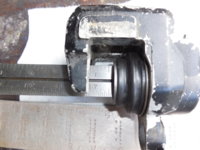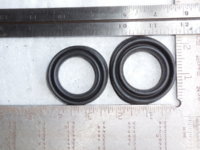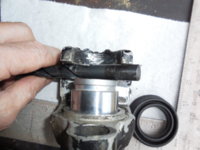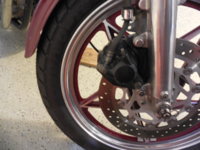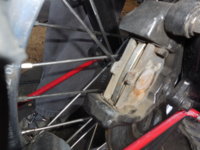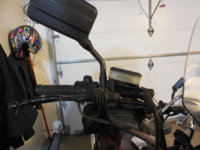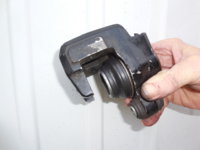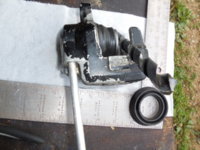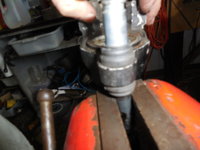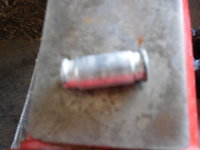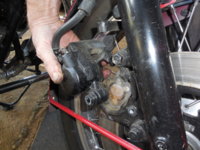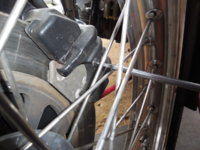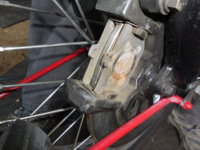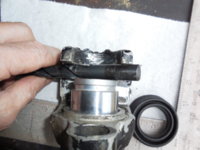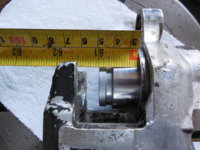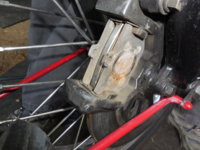Thanks for opening this thread Jay! You can be the poster boy for a BRAND NEW brake technique I am VERY exited about.
Wow expectations are sky high now.
One of the boyo's here was on this track, but I think I have gone a step further and found the holy grail. So far this applies only to 77-84 single piston, single caliper brake systems.
You can get rock hard brake lever with (drum roll please) NO BLEEDING needed.
Impossible you say!
But tested and proven!
OK will follow up with pics but I did this for the first time this week on a 79 special that was through the shop on a quick flip (yeah I'm a shameless Yankee Trader) sue me LOL
MC piston was stuck in, Zero brake action. I stripped and cleaned caliper and MC. (I don't advocate this part) but it was a special with rototiller bars and I didn't have a long enough brake line, so I flushed the existing lines with brake cleaner and air pressure. Caliper piston was rusty, so replaced with new piston. There's threads on the overhauls in tech.
First note; there is no need to remove the caliper bracket from the fork for an overhaul, Use a screwdriver to back out the pad retaining screw from the rear, remove the one bolt that holds the caliper to the bracket, remove caliper from bracket. If you have removed the bracket for cleaning it can be reinstalled to the fork leg with the two bolts washers and lock washers, the pads should be installed on the bracket now.
Caliper back together, mounting sleeve lubricated, OP: that sleeve inside the rubber grommet must be lightly greased and move freely.
To assemble; the piston is inserted fully, you need it pushed in all the way in to get the dust seal and retaining ring back in place. Doing that is sure fiddly, and it's a pain to get it back together without a loop of dust seal rubber at the ring gap isn't it? Install the pad tensioning spring bracket, tighten the pad retaining screw just enough to keep the bracket in place.
OK here's gggGary's "secret" (about time?)
Mc is on the handle bar turned so the path from caliper to reservoir is all uphill, no low spots to trap air. On the side stand bars full left usually is enough, on specials with the angled Mc you may need to rotate the MC on the bar a bit or even rotate the bars forward in the risers so the path is ALL uphill.
Next; You are holding the assembled caliper in your hand. no brake line or banjo attached. Just the caliper. You need to be very careful now, don't want any fingers removed or holes in the shop walls. Bleeder in and tightened. (you won't need to use it). Use a BIT of compressed air, don't try to seal your air gun to the brake line opening. and carefully use the air to extend the piston to it's outer limit. the rubber boot will be smooth no folds left. (will add pics, and a measurement later) A C-clamp to limit how far the piston extends would be smart. So now you have a caliper with a BIG reservoir behind the piston (but just full of air). Now, turn and hold the caliper so the hole where the brake line attaches is pointed straight up and slowly dribble fresh brake fluid into the caliper until it is filled. Do not attach the caliper to the bracket yet. Attach the brake line, banjo bolt, and two copper washers. Get the banjo bolt as snug as you can with the 12mm wrench. A light smack on the wrench with rubber mallet will help.
Finally the core "trick". With the brake line bolt pointed up so it's at the high point of the caliper, caliper held low so the fluid path to the MC is all uphill, slowly squeeze the piston in. If you have done a good job of cleaning and assembly this can be done easily with your thumbs. Brake fluid will go up the line through the MC and into the reservoir. You now have the piston fully retracted and can install the caliper to the bracket and pads with the bolt through the sleeve, With the caliper installed, finish tightening the pad retaining screw, the banjo bolt, and bleeder.
Add a bit of brake fluid to the reservoir, use the lever and pump the piston out so the pads contact the rotor, because the reservoir is at an angle keep a close watch on fluid level, it will go down as you pump out the piston. Go ahead and give a quick squeeze, release of the lever a time or two, this gets any little air bubbles hiding in the MC bore out to the reservoir. you will see the bubbles rising in the reservoir. now straighten the bars, and finish filling the reservoir, done!
A bit later and the next day repeat the side stand bars left squeeze release a time or two. I do this on a semi regular basis on all my brake systems, it keeps best lever feel. Do it with hydraulic clutch levers also. Tilt and turn to the right for the clutch.
To the OP even if you have your system assembled this is a worthwhile technique, yes it will be painful to open it up again, but this really works. The all uphill path is critical.
Last winter I did an overhaul with NO bleeding just by setting up the all uphill path and squeezing, releasing the lever waiting and repeating, it took a while 100 squeezes? but I got full hard lever, only cracking the bleeder to remove the small air pocket that sits in the top of the caliper that can't go up the line when the caliper is assembled on the fork. But the technique above is MUCH better, faster, easier.

